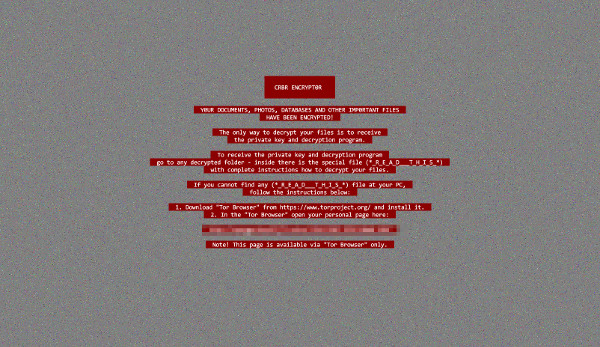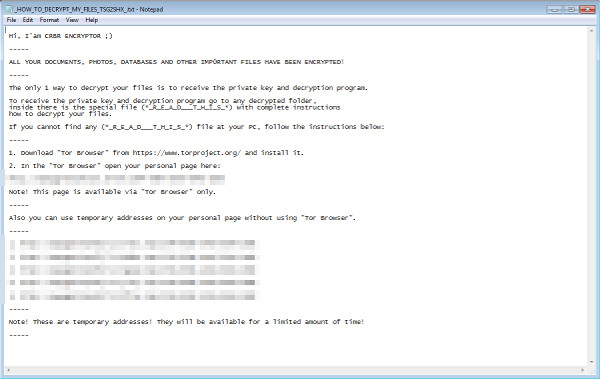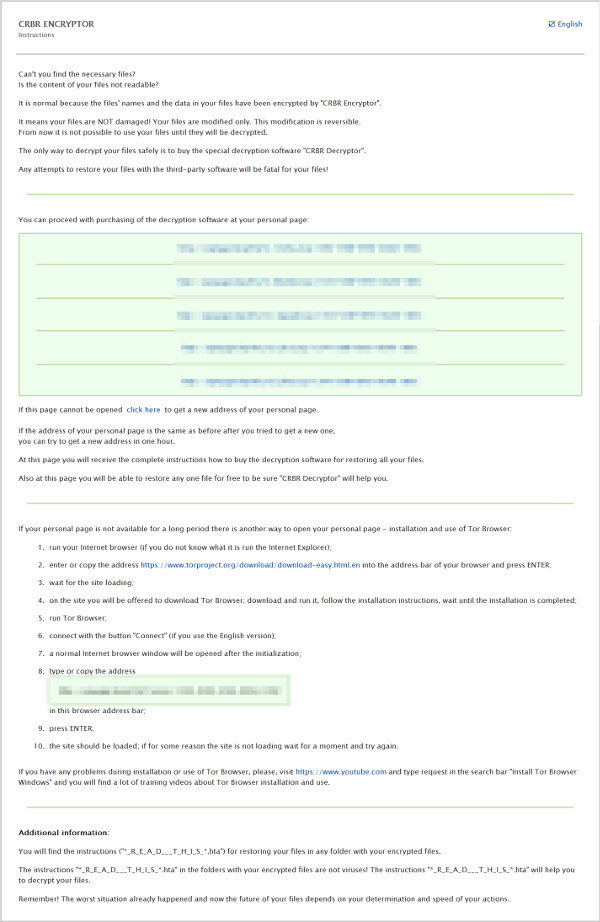RANSOM_CERBER.BG
Ransom:Win32/Cerber (Microsoft); Ransom.Cerber (Symantec)
Windows


Threat Type: Ransomware
Destructiveness: No
Encrypted: No
In the wild: Yes
OVERVIEW
Dropped by other malware, Downloaded from the Internet
This Ransomware arrives on a system as a file dropped by other malware or as a file downloaded unknowingly by users when visiting malicious sites.
It modifies the Internet Explorer Zone Settings.
It connects to certain websites to send and receive information.
It encrypts files with specific file extensions. It encrypts files found in specific folders.
TECHNICAL DETAILS
95,905,140 bytes
EXE
Yes
10 Aug 2017
Encrypts files, Drops files
Arrival Details
This Ransomware arrives on a system as a file dropped by other malware or as a file downloaded unknowingly by users when visiting malicious sites.
Autostart Technique
This Ransomware drops the following shortcut pointing to its copy in the User Startup folder to enable its automatic execution at every system startup:
- {malware name}.lnk
Other System Modifications
This Ransomware changes the desktop wallpaper by modifying the following registry entries:
HKEY_CURRENT_USER\Control Panel\Desktop
Wallpaper = "%TEMP%\tmp{random}.bmp"
It sets the system's desktop wallpaper to the following image:
Web Browser Home Page and Search Page Modification
This Ransomware modifies the Internet Explorer Zone Settings.
Dropping Routine
This Ransomware drops the following files:
- %Desktop%\_HOW_TO_DECRYPT_MY_FILES_{random characters}_.hta
- %Desktop%\_HOW_TO_DECRYPT_MY_FILES_{random characters}_.txt
- %TEMP%\{8 random characters}\{4 random characters}.tmp
- %TEMP%\tmp{random}.bmp
- {folder of encrypted files}\_HOW_TO_DECRYPT_MY_FILES_{random characters}_.hta
(Note: %Desktop% is the desktop folder, where it usually is C:\Documents and Settings\{user name}\Desktop in Windows 2000, Windows Server 2003, and Windows XP (32- and 64-bit); C:\Users\{user name}\Desktop in Windows Vista (32- and 64-bit), Windows 7 (32- and 64-bit), Windows 8 (32- and 64-bit), Windows 8.1 (32- and 64-bit), Windows Server 2008, and Windows Server 2012.)
Other Details
This Ransomware connects to the following website to send and receive information:
- 15.42.13.0/27:6893
- 44.66.140.0/27:6893
- 87.98.176.0/22:6893
It executes the following command to disable/stop/delete Windows components:
- %System%\netsh.exe advfirewall set allprofiles state on
- %System%\netsh.exe advfirewall reset
(Note: %System% is the Windows system folder, where it usually is C:\Windows\System32 on all Windows operating system versions.)
Ransomware Routine
This Ransomware encrypts files with the following extensions:
- .doc
- .docx
- .xls
- .xlsx
- .jpg
- .jpeg
- .rar
- .zip
- .ppt
- .pptx
- .avi
- .mpg
- .mpeg
- .wmv
It encrypts files found in the following folders:
- \bitcoin\
- \excel\
- \microsoft sql server\
- \microsoft\excel\
- \microsoft\microsoft sql server\
- \microsoft\office\
- \microsoft\onenote\
- \microsoft\outlook\
- \microsoft\powerpoint\
- \microsoft\word\
- \office\
- \onenote\
- \outlook\
- \powerpoint\
- \steam\
- \the bat!\
- \thunderbird\
- \word\
It avoids encrypting files with the following strings in their file name:
- bootsect.bak
- iconcache.db
- ntuser.dat
- thumbs.db
It avoids encrypting files with the following strings in their file path:
- :\$getcurrent\
- :\$recycle.bin\
- :\$windows.~bt\
- :\$windows.~ws\
- :\boot\
- :\documents and settings\all users\
- :\documents and settings\default user\
- :\documents and settings\localservice\
- :\documents and settings\networkservice\
- :\intel\
- :\logs\
- :\msocache\
- :\perflogs\
- :\program files (x86)\
- :\program files\
- :\programdata\
- :\recovery\
- :\recycled\
- :\recycler\
- :\system volume information\
- :\system.sav\
- :\temp\
- :\windows.old\
- :\windows10upgrade\
- :\windows\
- :\winnt\
- \appdata\local\
- \appdata\locallow\
- \appdata\roaming\
- \local settings\
- \public\music\sample music\
- \public\pictures\sample pictures\
- \public\videos\sample videos\
- \tor browser\
It leaves text files that serve as ransom notes containing the following text:
NOTES:
It avoids infecting system with the following OS language codes:
SOLUTION
9.850
13.586.05
10 Aug 2017
13.587.00
11 Aug 2017
Step 1
Before doing any scans, Windows XP, Windows Vista, and Windows 7 users must disable System Restore to allow full scanning of their computers.
Step 2
Note that not all files, folders, and registry keys and entries are installed on your computer during this malware's/spyware's/grayware's execution. This may be due to incomplete installation or other operating system conditions. If you do not find the same files/folders/registry information, please proceed to the next step.
Step 3
Scan your computer with your Trend Micro product to delete files detected as RANSOM_CERBER.BG. If the detected files have already been cleaned, deleted, or quarantined by your Trend Micro product, no further step is required. You may opt to simply delete the quarantined files. Please check this Knowledge Base page for more information.
Step 4
Search and delete this file
- %Desktop%\_HOW_TO_DECRYPT_MY_FILES_{random characters}_.hta
- %Desktop%\_HOW_TO_DECRYPT_MY_FILES_{random characters}_.txt
- %TEMP%\{8 random characters}\{4 random characters}.tmp
- %TEMP%\tmp{random}.bmp
- {folder of encrypted files}\_HOW_TO_DECRYPT_MY_FILES_{random characters}_.hta
Step 5
Reset your Desktop properties
Step 6
Restore encrypted files from backup.
Did this description help? Tell us how we did.




